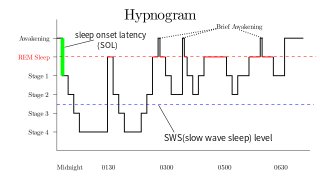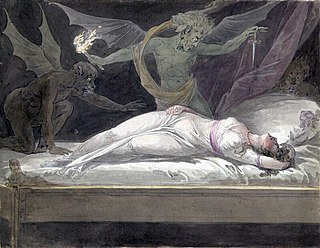Paralysis is a loss of motor function in one or more muscles. Paralysis can also be accompanied by a loss of feeling in the affected area if there is sensory damage. In the United States, roughly 1 in 50 people have been diagnosed with some form of permanent or transient paralysis. The word "paralysis" derives from the Greek παράλυσις, meaning "disabling of the nerves" from παρά (para) meaning "beside, by" and λύσις (lysis) meaning "making loose". A paralysis accompanied by involuntary tremors is usually called "palsy".

Sleep is a state of reduced mental and physical activity in which consciousness is altered and sensory activity is inhibited to a certain extent. During sleep, there is a decrease in muscle activity, and interactions with the surrounding environment. While sleep differs from wakefulness in terms of the ability to react to stimuli, it still involves active brain patterns, making it more reactive than a coma or disorders of consciousness.
A nightmare, also known as a bad dream, is an unpleasant dream that can cause a strong emotional response from the mind, typically fear but also despair, anxiety, disgust or sadness. The dream may contain situations of discomfort, psychological or physical terror, or panic. After a nightmare, a person will often awaken in a state of distress and may be unable to return to sleep for a short period of time. Recurrent nightmares may require medical help, as they can interfere with sleeping patterns and cause insomnia.

A sleep disorder, or somnipathy, is a medical disorder of an individual's sleep patterns. Some sleep disorders are severe enough to interfere with normal physical, mental, social and emotional functioning. Polysomnography and actigraphy are tests commonly ordered for diagnosing sleep disorders.

Insomnia, also known as sleeplessness, is a sleep disorder where people have trouble sleeping. They may have difficulty falling asleep, or staying asleep for as long as desired. Insomnia is typically followed by daytime sleepiness, low energy, irritability, and a depressed mood. It may result in an increased risk of motor vehicle collisions, as well as problems focusing and learning. Insomnia can be short term, lasting for days or weeks, or long term, lasting more than a month. The concept of the word insomnia has two possibilities: insomnia disorder and insomnia symptoms, and many abstracts of randomized controlled trials and systematic reviews often underreport on which of these two possibilities the word insomnia refers to.

Rapid eye movement sleep is a unique phase of sleep in mammals and birds, characterized by random rapid movement of the eyes, accompanied by low muscle tone throughout the body, and the propensity of the sleeper to dream vividly.

Dementia with Lewy bodies (DLB) is a type of dementia characterized by changes in sleep, behavior, cognition, movement, and regulation of automatic bodily functions. Memory loss is not always an early symptom. The disease worsens over time and is usually diagnosed when cognitive impairment interferes with normal daily functioning. Together with Parkinson's disease dementia, DLB is one of the two Lewy body dementias. It is a common form of dementia, but the prevalence is not known accurately and many diagnoses are missed. The disease was first described by Kenji Kosaka in 1976.

Sleep paralysis is a state, during waking up or falling asleep, in which one is conscious but in a complete state of full-body paralysis. During an episode, one may hallucinate, which often results in fear. Episodes generally last no more than a few minutes. It can recur multiple times or occur as a single episode.
A hypnic jerk, hypnagogic jerk, sleep start, sleep twitch, myoclonic jerk, or night start is a brief and sudden involuntary contraction of the muscles of the body which occurs when a person is beginning to fall asleep, often causing the person to jump and awaken suddenly for a moment. Hypnic jerks are one form of involuntary muscle twitches called myoclonus.

Night terror, also called sleep terror, is a sleep disorder causing feelings of panic or dread and typically occurring during the first hours of stage 3–4 non-rapid eye movement (NREM) sleep and lasting for 1 to 10 minutes. It can last longer, especially in children. Sleep terror is classified in the category of NREM-related parasomnias in the International Classification of Sleep Disorders. There are two other categories: REM-related parasomnias and other parasomnias. Parasomnias are qualified as undesirable physical events or experiences that occur during entry into sleep, during sleep, or during arousal from sleep.

An incubus is a demon in male form in folklore that seeks to have sexual intercourse with sleeping women; the corresponding spirit in female form is called a succubus. Parallels exist in many cultures.

Nightmare disorder is a sleep disorder characterized by repeated intense nightmares that most often center on threats to physical safety and security. The nightmares usually occur during the REM stage of sleep, and the person who experiences the nightmares typically remembers them well upon waking. More specifically, nightmare disorder is a type of parasomnia, a subset of sleep disorders categorized by abnormal movement or behavior or verbal actions during sleep or shortly before or after. Other parasomnias include sleepwalking, sleep terrors, bedwetting, and sleep paralysis.

A mare is a malicious entity in Germanic and Slavic folklore that walks on people's chests while they sleep, bringing on nightmares.

The Nightmare is a 1781 oil painting by Swiss artist Henry Fuseli. It shows a woman in deep sleep with her arms thrown below her, and with a demonic and ape-like incubus crouched on her chest. The painting's dreamlike and haunting erotic evocation of infatuation and obsession was a huge popular success.
Parasomnias are a category of sleep disorders that involve abnormal movements, behaviors, emotions, perceptions, and dreams that occur while falling asleep, sleeping, between sleep stages, or during arousal from sleep. Parasomnias are dissociated sleep states which are partial arousals during the transitions between wakefulness, NREM sleep, and REM sleep, and their combinations.

Narcolepsy is a chronic neurological disorder that involves a decreased ability to regulate sleep–wake cycles. Symptoms often include periods of excessive daytime sleepiness and brief involuntary sleep episodes. Narcolepsy paired with cataplexy is evidenced to be an autoimmune disorder. These experiences of cataplexy can be brought on by strong emotions. Less commonly, there may be vivid hallucinations or an inability to move while falling asleep or waking up. People with narcolepsy tend to sleep about the same number of hours per day as people without, but the quality of sleep tends to be lessened.
Sleep state misperception (SSM) is a term in the International Classification of Sleep Disorders (ICSD) most commonly used for people who mistakenly perceive their sleep as wakefulness, though it has been proposed that it be applied to those who severely overestimate their sleep time as well. While most sleepers with this condition will report not having slept in the previous night at all or having slept very little, clinical recordings generally show normal sleep patterns. Though the sleep patterns found in those with SSM have long been considered indistinguishable from those without, some preliminary research suggest there may be subtle differences.

Three Anglo-Saxon metrical charms "Against a dwarf" are contained within the Lacnunga, which seek to heal an afflicted person by ridding them of a dwarf.

An anxiety dream is an unpleasant dream which can be more disturbing than a nightmare. Anxiety dreams are characterized by the feelings of unease, distress, or apprehension in the dreamer upon waking. Anxiety dreams tend to occur in rapid eye movement sleep, and usual themes involve incomplete tasks, embarrassment, falling, getting in to legal or financial trouble, failed pursuits and being pursued by another, often an unrealistic entity but other human beings can also be the pursuer. Anxiety dreams may be caused by childhood trauma, or an adult dealing with conflict. Though they create anxiety in the dreamer, anxiety dreams also serve as a way for a person's ego to reset.

The night hag or old hag is the name given to a supernatural creature, commonly associated with the phenomenon of sleep paralysis. It is a phenomenon which a person feels during a presence of a supernatural malevolent being which immobilizes the person as if sitting on their chest or the foot of their bed. The word "night-mare" or "nightmare" was used to describe this phenomenon before the word received its modern, more general meaning. Various cultures have various names for this phenomenon andr supernatural character.











